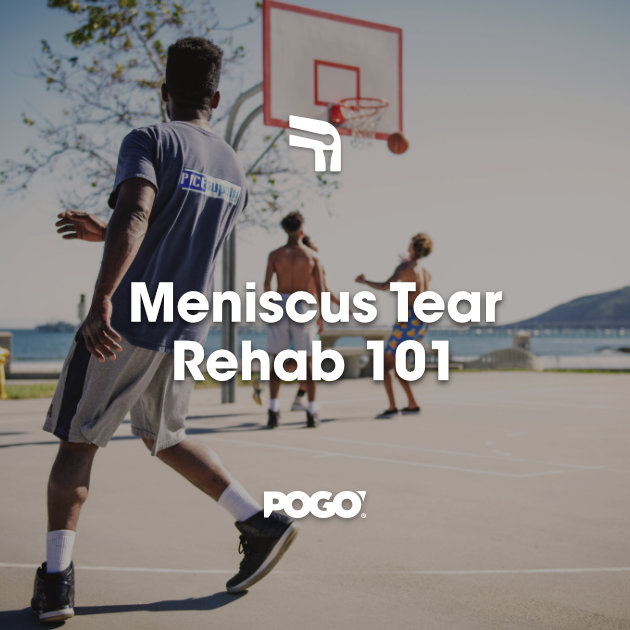Would taping help my knee pain?
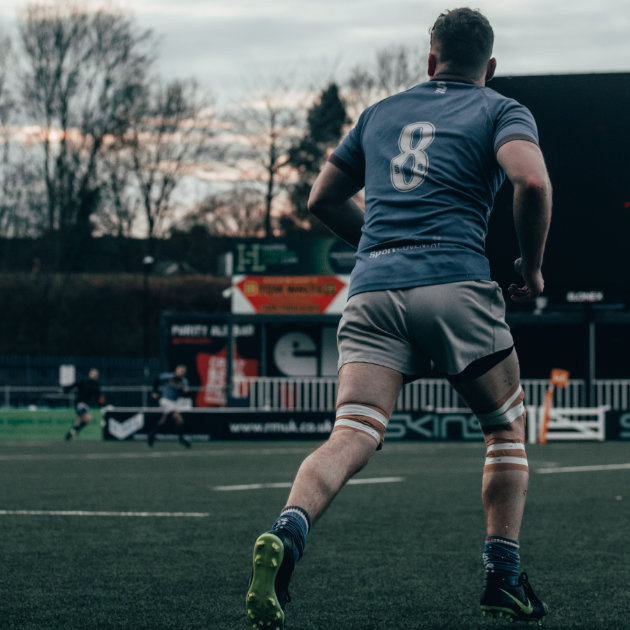
It is believed by some that therapeutic taping for those with knee pain has the potential to offer an inexpensive, simple and effective option for the client to reduce their symptoms without the use of medications (1). In this blog I touch on a few studies that investigated tape’s potential benefits on knee conditions such as Osteoarthritis (OA), Patellofemoral Pain Syndrome (PFPS) and Patellar Tendinopathy (PT).
Taping for knee osteoarthritis
The method of application and what type of tape to use has been investigated on many sources of knee pain. One common source that tape is applied to is knee osteoarthritis. Knee osteoarthritis (OA) is one of the most common debilitating diseases of the knee associated with aging – affecting 9% of men and 18% of women over the age of 65 (1). Medications have been shown to reduce pain related to OA, however, as the condition is related to aging – these methods have the potential to be problematic due the chronic nature of OA (1). The pain relieving effects of knee bracing and tape remains disputed in the literature – however, some studies have shown that with correct application, taping may be a viable treatment option for clients to manage their knee pain (1).
A study in 2016 compared the pain in 15 knee OA clients – the comparison was between their pain at baseline and the three groups: no tape, fake tape and therapeutic tape. The taping methods are as below (1):
- No tape: no tape attached
- Sham tape: three strips of tape were loosely attached to the skin of the participant above and below the knee joint
- Therapeutic tape: a four-piece knee taping method for OA. Tape was used to medially align and tilt the patella, with the overall goal to alleviate pressure from the infra-patella fat pad. This is shown in figure 4.
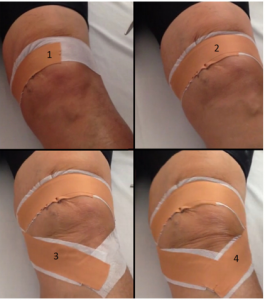
Figure 4: Therapeutic tape applied to OA clients
The study used the KOOS (Knee injury and Osteoarthritis Outcome Score) as well as a VAS pain scale to determine the effectiveness of the tape. The aggregate pain scores are displayed in figure 3. Those with the therapeutic tape applied to the knee showed significantly lower pain scores while walking (1).

It is also important to note that while improvements of pain were achieved, the tape had no effect on alternating the OA clients’ lower limb kinematics, kinetics nor muscle activation as they walked (1).
Taping for patellofemoral pain
Patellofemoral pain syndrome (PFPS) is another common source of knee pain and is present in a variety of sports – making up 30% of presentations to sport clinics (2). Uncertainty exists in regards to its cause however studies have shown its relationship to quadricep weakness, joint laxity, overuse injuries and biomechanics/kinematics of the knee when loading (2). The strongest evidence related to PFPS is weakness or imbalance of the quadriceps muscles with researchers believing a weak vastus medialis obliquus (VMO) in comparison to the vastus lateralis (VL). This imbalance can, in turn, cause lateral tilting of the patella and thus, increase their symptoms (2).
Kinesio tape (KT) is one of the most commonly used tapes, particularly in an athletic population, as it can play a role in the prevention and management of pain/injury without restricting their performance (2). It is proposed that KT can either inhibit or facilitate a muscle’s contraction depending on its application (2). A study in 2017 investigated whether or not KT can improve VMO activation and therefore reduce symptoms in a PFPS population of 15.
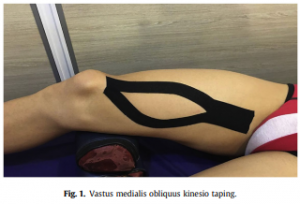
The method of application is shown above in figure 1 – the KT was applied at 75% of maximal length tension to provide the desired muscle facilitation effect (2).
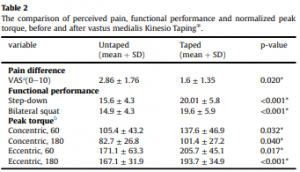
The results (in table 2) of the study showed a significant reduction of pain scores (VAS) when the VMO was taped compared to when it was not taped (2). It also showed increases in peak forces of the quadriceps concentrically and showing statistically significant increases in regards to eccentric forces (2).
This study is consistent with another that showed improved symptoms in those with real KT versus those with sham tape – however, this application was over the patella and not on the VMO alone (2). This study recommended that VMO taping for PFPS in an athletic population may be appropriate (2).
Taping for patella tendinopathy
Patellar tendinopathy (PT), also known as Jumper’s knee – is an overuse injury of the patella tendon commonly related to activity or sport that requires a high frequency and/ or /velocity of knee extension via the quadricep muscles (eg. jumping). Due to the severity and longevity of PT – performances of those with it will often deteriorate or in some cases cause a complete cessation of the activity or sport that causes symptoms (3).
Many athletes and clinicians will use a patellar strap or tape in an attempt to reduce symptoms originating from their injury (3). A study in 2016 investigated and compared participants with no tape, sports tape, a patellar strap and fake tape (seen in figure 2).
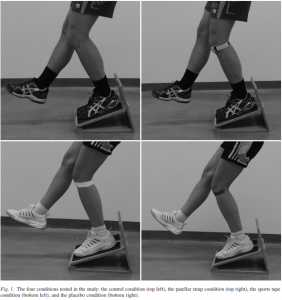
Figure 2: Four conditions looked at in the study: control (top left), patellar strap (top right), sports tape (bottom left) and sham tape (bottom right)
The results (seen in figures 5 and 6) showed that the use of a strap or tape of any kind, including the fake tape, had a positive effect on the symptoms experienced throughout their sport as well as 2 hours afterwards (3). However, these improvements were short-term and the long-term effects remain unknown.
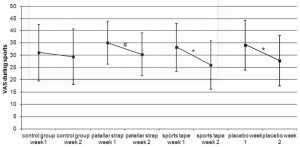
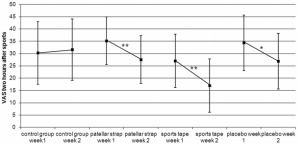
Figure 6: Pain (VAS) two hours after sport in weeks 1 and 2 for the various groups
The improvement obtained from the patella straps and sports tape may be a result of reduced patella tendon strain or improved proprioception during their sport (3). However, researchers believe that their use may also have negative effects on the tenon as athletes can push their injured tendon as they have reduced pain while the strap or tape is on (3).
Summary
Tape’s effect on knee-related injuries or conditions remains debatable within the literature – with some studies even showing placebo playing a role of the improvement of pain. I believe tape may play a role with appropriate presentations in an attempt to reduce symptoms. Whether it be marginally or dramatically – majority of clients will value any reduction of symptoms and potentially be more on-board with the strength and conditioning work that current research underlines as most vital in rehabilitation of knee-related injuries.
“So will it help or not?”
To answer it simply – it may help with your knee-related pain depending on its source, stage of healing and application. One thing I can say with more certainty is this – improving the capacity of the knee via adjacent musculature’s strength and conditioning will help your knee pain, and there’s already blogs on that.
For more information on the following conditions as well as what exercises/advice can help you get back to your physical best – click the following links:
For Patellofemoral Pain Syndrome

Alec Lablache
POGO Physiotherapist
Featured in the Top 50 Physical Therapy Blog
Book an Appointment with Alec here
References:
- Edmonds, D. W., McConnell, J., Ebert, J. R., Ackland, T. R., & Donnelly, C. J. (2016). Biomechanical, neuromuscular and knee pain effects following therapeutic knee taping among patients with knee osteoarthritis during walking gait. Clinical Biomechanics, 39, 38-43. doi:10.1016/j.clinbiomech.2016.09.003
- Aghapour, E., Kamali, F., & Sinaei, E. (2017). Effects of kinesio taping® on knee function and pain in athletes with patellofemoral pain syndrome. Journal of Bodywork & Movement Therapies, 21(4), 835-839. doi:10.1016/j.jbmt.2017.01.012
- Vries , d., A, Zwerver, J., Diercks, R., Tak, I., van Berkel, S., van Cingel, R., . . . van den Akker-Scheek, I. (2016). Effect of patellar strap and sports tape on pain in patellar tendinopathy: A randomized controlled trial. Scandinavian Journal of Medicine & Science in Sports, 26(10), 1217-1224. doi:10.1111/sms.12556







